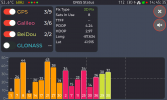We have a lot of complaining in other threads about how slow the
Mavic 3 is to record a home point when starting up. We have plenty of evidence that it takes longer. But we do not have enough constructive discussion. I would like to try a different approach in this thread. There clearly is something different in how the
Mavic 3 acquires satellites and records the home point. If DJI isn't going to be forthright about it (not holding my breath), there are still things we can do to move the discussion forward and maybe help ourselves.
For this thread, I'd like to offer up some areas in which we can actually start to figure some things out:
1. We know one material difference between the
Mavic 3 vs. prior DJI drones is the swap of GLONASS to Beidou. We do NOT know if this change impacts how long it takes to record a home point. If there are known differences in the user experience between Beidou and GLONASS, Galileo, and GPS, it would be worth knowing. Could swapping them back make a difference? It is a mere configuration change to make it happen.
2. It appears, but I cannot say for sure, that DJI has changed their "GPS Health" criteria for recording a home point. My only evidence of this is the apparent need for 12 or more sats vs. 9 or so on older DJI drones. Not only does it take longer to get SVs but it also wants more of them to get going. Can someone reference and/or document the technical details that define the relationship between SV count, HDOP, GPS Health and the time to first home point.
3. We do NOT know if DJI is using different hardware or antennas for GNSS in the
Mavic 3. A tear down would tell us if there is another newer uBlox chip in there with a Taoglass antenna or if DJI is using different parts this time which may explain some of the differences in what we're seeing. I have not seen any identification of chips, antennas in tear downs so far. If you come across them, post them here. If you have a busted
Mavic 3 you want to offer up for autopsy, please let me know.
4. We need to push DJI to use A-GPS. We have expensive tablets, phones and RC Pros wired up to these things. It would not be hard to download current ephemeris and almanac data via these devices. For those not familiar, A-GPS is how the GNSS is so fast on your phone. It downloads all the SV geometry, etc. from the internet instead of trying to pull it off the GNSS signal itself. This would fundamentally change the experience. The time to first home point would be under 30 seconds every time.
5. Other topics I cannot think of?













